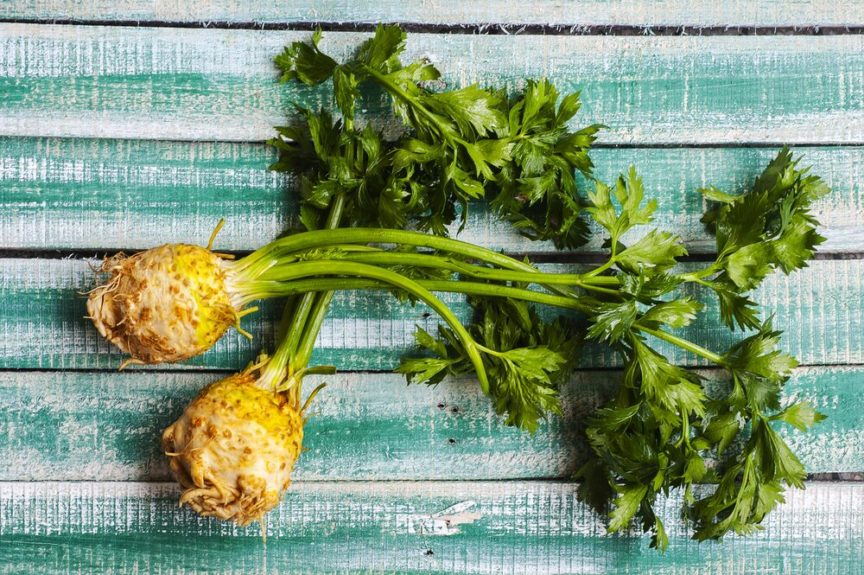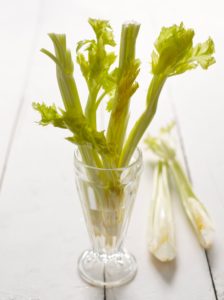 White on time! A unique British ingredient, Fenland celery is dubbed ‘winter asparagus’ (in season October to December).
White on time! A unique British ingredient, Fenland celery is dubbed ‘winter asparagus’ (in season October to December).
A traditional Victorian variety, recently revived, Fenland celery has a sweet-nutty flavour with obligatory crispy crunch. In 2013 Fenland celery became the first English vegetable to be awarded PGI (Protected Geographical Indication) status by the European Protected Food Names Scheme. It is grown using traditional techniques, such as using a special ‘earthing up’ process to keep the celery warm… and white.
A summer salad staple, celery is often overlooked as the nights draw in and we look for warming dishes but celery can be used tin many tasty autumn and winter recipes when added to hotpots, pasties and sausage rolls. With almost no carbs or cals, it’s an easy add that does not mean having to worry about extra insulin doses.
Fenland celery’s pale colour is down to its cultivation method where sun is prevented from touching the stems and turning them green. It’s also sometimes called ‘winter white celery’. The 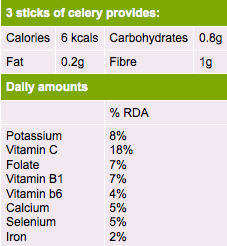 earthing up process gives the celery its unique ‘nutty-sweet’ flavour. The growing method also allows for more of the root, which has great flavour, to be kept. It is traditionally trimmed to a pencil point. Immersing most of the celery in the rich Fenland soil as it grows gives it a unique ‘nutty-sweet’ flavour and a less stringy texture, while still delivering a crisp crunch.
earthing up process gives the celery its unique ‘nutty-sweet’ flavour. The growing method also allows for more of the root, which has great flavour, to be kept. It is traditionally trimmed to a pencil point. Immersing most of the celery in the rich Fenland soil as it grows gives it a unique ‘nutty-sweet’ flavour and a less stringy texture, while still delivering a crisp crunch.
Just three sticks of celery equals one of your recommended five-a-day fruit and veg portions. The same three sticks of celery have 6 calories, about 1g of carbohydrate, almost no fat, and 1g of fibre. It has a bit of calcium, selenium, Vitamin B1 and folate (5-7% RDA of each) and a fairly good dose of vitamin C (18% of RDA — recommended daily allowance). A great choice for slimmers, celery has a high water and fibre content and its crunchy texture gives it a high Satiety Value, which means it helps you feel full.
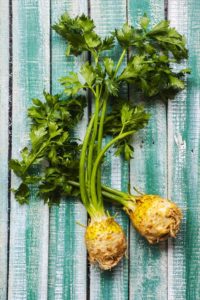 Wild celery has been used by man for almost 3,000 years but was originally regarded as a medicine, not as food. Traditionally it was used in Asian medicine to treat high blood pressure as it contains potassium which helps control blood pressure. It also contains something (3-n-butyl phthalide if you must know), which helps to reduce blood pressure by relaxing blood vessels and is one of the components that gives celery its characteristic smell and taste.
Wild celery has been used by man for almost 3,000 years but was originally regarded as a medicine, not as food. Traditionally it was used in Asian medicine to treat high blood pressure as it contains potassium which helps control blood pressure. It also contains something (3-n-butyl phthalide if you must know), which helps to reduce blood pressure by relaxing blood vessels and is one of the components that gives celery its characteristic smell and taste.
The dietary fibre in celery helps protect against problems like constipation and haemorrhoids. A study assessing the role of diet in the development of colon cancer found a strong protective effect from celery. Recent research has also indicated that compounds found in celery may help combat Alzheimer’s and other degenerative mental illnesses. This research is still in the early stages, but a healthy balanced diet, rich in fruit and vegetables, should help reduce the risk of dementia.
The history of Fenland celery
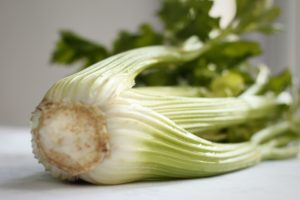 In Victorian times, celery specially grown in the Fens for the Christmas market (available from mid-November to New Year’s Day, depending on the weather) was extremely popular. It started out as an artisan product specially grown for the London markets. The celery travelled straight from the fields to Shippea Hill station near Ely where it was then sent to London by rail. Once there, the cold, dry and frost-proof conditions of the railway arches in the markets were considered to be the perfect storing environment until the 60s when lorries took over the load and taking the celery to market. It was grown in very wide rows split by deep trenches – this allowed for the black Fen soil to be banked up around the celery to protect it from frost and ‘blanch’ it, which is how it has
In Victorian times, celery specially grown in the Fens for the Christmas market (available from mid-November to New Year’s Day, depending on the weather) was extremely popular. It started out as an artisan product specially grown for the London markets. The celery travelled straight from the fields to Shippea Hill station near Ely where it was then sent to London by rail. Once there, the cold, dry and frost-proof conditions of the railway arches in the markets were considered to be the perfect storing environment until the 60s when lorries took over the load and taking the celery to market. It was grown in very wide rows split by deep trenches – this allowed for the black Fen soil to be banked up around the celery to protect it from frost and ‘blanch’ it, which is how it has
Food features and recipes like this appear in the Desang Diabetes Magazine, our free-to-receive digital journal. We cover diabetes news, diabetes ‘kit’ and information on food suitable for maintaining good blood glucose control or a diabetic diet, including a regular Making Carbs Count column.

